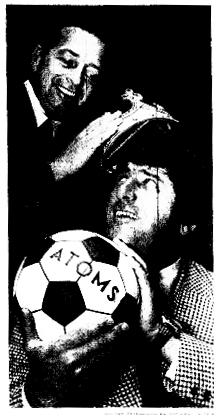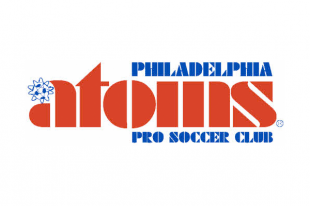August 25th is the 40th anniversary of the Philadelphia Atoms’ NASL championship win over the Dallas Tornado. PSP will be celebrating the Atoms and their historic inaugural season championship win with a series of articles in the run up to the anniversary. The series continues with a look at how Philadelphia ended up with its first NASL franchise.
It all started easily enough…
Philadelphia native Tom McCloskey was a successful construction magnate, taking over McCloskey & Son Builders, Inc. in 1961 from his father, who was named Ambassador to Ireland. Among other things, the company served as general contractor on the Spectrum construction project.
Not content with being a successful businessman, McCloskey was eager to get involved in professional sports–a National Football League franchise, in particular. The hometown Eagles were not for sale, however, so McCloskey was forced to be a mere fan for awhile. Of course, having deeper pockets than your average fan, McCloskey could afford to linger on the fringes of the NFL’s power base.
The most expensive Super Bowl tickets ever
In 1973, McCloskey was in Los Angeles for the Super Bowl with eight friends…but zero tickets.
Lamar Hunt, owner of the NFL’s Kansas City franchise, learned of McCloskey’s dilemma, and found nine tickets for him. The tickets would even be free of charge–sort of.
You see, Hunt was also owner of the North American Soccer League’s Dallas Tornado franchise, and was always on the lookout for new investors in the 4-year old league. So, dealing in a position of strength, Hunt casually asked McCloskey, “How would you like to have a soccer franchise in Philadelphia?” McCloskey, needing the tickets and quite able to take a hint, agreed to buy an NASL franchise. Thus, for the sum of $25,000, the Philadelphia Atoms were born.
We have a team—now what?
McCloskey was no novice to sports ownership. He had previously owned the old Philadelphia Ramblers of the Eastern Hockey League, and had been president of the Liberty Bowl football game just before it left the city. This time around, he wanted to run a successful franchise, and put his mind to ensuring that his new soccer team would be just that.
Once back in Philadelphia, McCloskey realized he had about three months to get the team ready for a May 5 start date. With hardly a thought, McCloskey appointed Bob Ehlinger, a marketing vice-president with his firm, as general manager of the club. For his part, Ehlinger had no soccer experience whatsoever; his sports experience consisted of his 20 years as a college football official.
A recipe for disaster, right?
Ironically, the two men’s total inexperience would ultimately prove advantageous, and create a recipe for unprecedented success in U.S. professional soccer.
We need a coach
While experienced “soccer men” at the time might have hired some English veteran to put together a club, McCloskey and Ehlinger went to where a professional American football team would be more likely to go to get a coach–the college ranks.
With nothing else to go by, they targeted a local boy. Al Miller had been an All-American soccer player at East Stroudsburg State in Pennsylvania, and was currently coaching a collegiate soccer powerhouse at Hartwick. To McCloskey and Ehlinger, he seemed a logical choice.
Miller himself was less than enthusiastic. He was all-too-familiar with the NASL’s history, and was dubious about his professional chances. However, Miller became convinced that McCloskey was worth taking a chance on after being impressed by the owner’s breaking a window at his home while trying to kick a ball past his son. With not much ado, the Atoms had a coach. Now all the team needed was some players.
We need players
Again, the status quo in American pro soccer was to go to England and grab some aging Third and Fourth Division players “on loan” to fill a roster. And, once again, McCloskey and Ehlinger’s naïveté and “American-centric” approach would yield some unexpectedly positive results.
McCloskey and Ehlinger were inclined to use the American football model for franchise building, and concentrated on the upcoming NASL draft. Miller, who was more than happy to build an American squad, used the first pick overall in the 1973 draft to tab Bob Rigby, an outstanding goalkeeper from Miller’s alma mater. The next round saw Miller draft Rider University forward Bobby Smith.
Miller also picked up some Americans toiling in obscurity throughout the league. From Montreal he acquired Barry Barto, and from the New York Cosmos he grabbed former Penn All-American Stan Startzell. Rounding out the local connection, Miller signed Charlie Duccilli, holder of Temple University’s career scoring record and 1971 ASL leading scorer with the Philadelphia Spartans, and Casey Bahr of Navy, son of 1950 World Cup hero and former Philadelphia Nationals star (and Kensington native) Walt Bahr.
Miller and his charges were dispatched to England to train, at Lilleshall, the training site for the English national team. By training in England, Miller hoped to impress his young Americans with a top-flight facility in a “real” soccer country. Also, it gave him the opportunity to fill out his squad with British players who played the fast-moving style Miller preferred. As the NASL played a summer schedule, a number of English players were available on loan to American clubs. Miller borrowed three Southport footballers–Andy Provan, Jim Fryatt, and Chris Dunleavy–and tried to make the best use of what little time he had to prepare for the 1973 season.
We need fans
Meanwhile, back in America, McCloskey and Ehlinger were doing a remarkable job of marketing both the team and the sport. The “Atoms” nickname had been selected in a name-the-team contest, and the winner received an all-expenses paid trip to Wembley for the FA Cup Final.
The club also reached out to the well-established local soccer community, and to youth programs in particular, eager to connect with and be a part of the historic Philadelphia soccer scene.
The local press covered the team enthusiastically. No doubt starved for positive stories, given the wasteland that was Philadelphia sports in 1973, the media were anxious to glom on to any team that had a chance to be a winner. Add a local, American coach with his cast of local, American players, and it was clear that the papers had a story.
Clearly, Miller, Ehlinger and McCloskey had been successful in wooing the press to their side. Now, the bigger question was whether the fans would come to the games.
And come, they did.
Click here to link to the rest of the series and more articles on the Atoms.



Comments